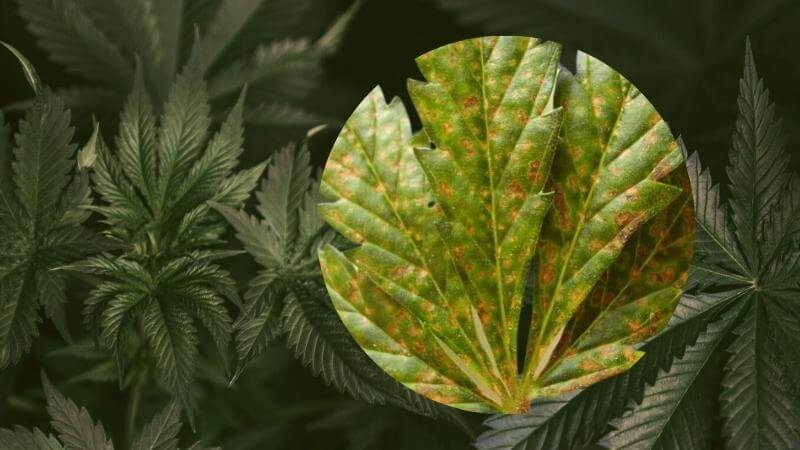While not as prevalent as bud rot and powdery mildew, Septoria leaf spot (yellow spot, or sometimes brown spot) is yet another fungal enemy faced by cannabis grows everywhere. Most commonly affecting outdoor growers, septoria affects plants from the bottom up. If left to its own devices, it can destroy entire crops just as they begin flowering.
Septoria leaf spot on cannabis is a challenge to treat once it takes hold. Preventative measures are the most effective method for reducing the risk of this fungal pathogen. Cultivators of all sizes should know the signs of early infection and how to manage the spread should it appear.
If you prefer visual content check out our YouTube channel here.
What is Septoria Leaf Spot (Yellow and Brown Spot)
Septoria, also called yellow spot or brown spot, is a fungal pathogen affecting many different species, including soybeans, tomatoes, and cannabis.
The fungus, Septoria lycopersici, survives in soil and spreads via microscopic spores. These float through the air, travel on the backs of insects or splash up from a contaminated surface. Although possible within indoor setups (especially those that use soil or fail to sterilize between crops), it's primarily outdoor growers who have to manage the risk of yellow spot.
Yellow spot thrives in warm, moist environments. During the late summer months, outdoors growers must pay careful attention to the weather. Frequent rains and hot temperatures will create a perfect setting for septoria. While not always possible, managing these wet periods is critical to reducing the risk.
What are the Signs of Septoria Leaf Spot
The first signs of yellow spot begin on the lower leaves, particularly within dense canopy areas. As the disease progresses, it spreads upwards. Outdoor growers typically notice the early signs in the later stages of veg in the late summer months, although it can strike at any point.
Signs of Yellow Spot in Cannabis
- Lower leaves develop yellow spots, which turn brown in the center.
- Spots dry out and turn brown as the fungal infection spreads.
- Spots are roughly round in shape and may have a grey raised pimple in the middle.
- Infected leaves spread upwards to eventually appear on the leaves around the developing flower.
- In the final stages of the infection, leaves turn brown, dry out, and die.
How to Prevent Yellow and Brown Spot
Environmental control and proper sterilization between crops are the easiest ways to mitigate the risk of ongoing yellow spot between crops.
Whether you grow indoors or outdoors, constant monitoring is key to early detection. When conditions are hot and humid, take your time checking for signs of septoria. Monitor the lower branches and leaves, and spray with fungicides when the risk is high.
Preventing Septoria in Indoor Cannabis Cultivation
For those growing indoors, maintain strict cleaning procedures for all equipment, plants, and substrate entering the grow room. Sterilize equipment, hydroponics setups, and recycled substrate between crops.
If a previous indoor cannabis crop struggled with septoria, dispose of the substrate and do not reuse it. Remove any dead leaves or debris from the room as soon as it falls.
You may also want to spray a mild fungicide or neem oil on clones before bringing them into a grow room to ensure there are no dormant yellow spot spores on the surface.
Environmental controls in the grow room are also necessary. Because yellow spots thrive in hot, humid environments, try to maintain a relative humidity level below 50 percent.
Avoid top-down watering, and excessive foliar sprays should humidity be an issue.
Preventing Septoria in Outdoor Cannabis Cultivation
Naturally, outdoor growers will have a more challenging time managing environmental conditions but you can reduce the risk.
Space plants wide to allow for better airflow. Prune regularly to allow better airflow within the densest parts of the plant. If growing directly in the soil, rotate your crop regularly. Do not reuse mulch, soil, or other materials from an infected crop. Whatever you do, do not put infected plants into your compost. Spores may survive to infect a future crop.
How to Treat Yellow and Brown Spot
As with many fungal pathogens, it is challenging to treat yellow spot in cannabis when it does appear. Constant monitoring, especially after a rainy period, and immediate action is the best bet.
First, remove any and all infected material, even if it means damaging the plant beyond the point of reduced yields. If the issue is with a single plant, it may even be worthwhile to remove that plant altogether.
Second, if it's still early in the infection, and if the plants are still in veg, it's safe to fungicides. Fungicides prevent more than they treat but could help reduce the spread and kill off any dormant spores on other plants.
Copper-based fungicidal sprays, full-spectrum fungicides, and neem oil are a few options. If the plants are in flower, it's unsafe to spray.
Yellow Spot in Cannabis a Challenging, but Preventable Disease
While bud rot and powdery mildew may get all the attention on forums for cannabis cultivators, but yellow spot is still a serious concern. Knowing the early signs, prevention tips, and treatment options is crucial to reducing the risk.
Monitoring plants daily, sterilizing equipment, and reducing humidity levels are all important steps. Outdoor growers must also take additional steps, like rotating crops, plant spacing, and intense pruning.
As with many cannabis diseases, ongoing prevention measures are the best way to avoid yellow spot disease.








